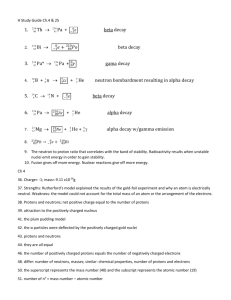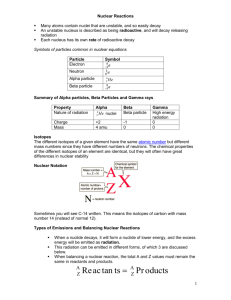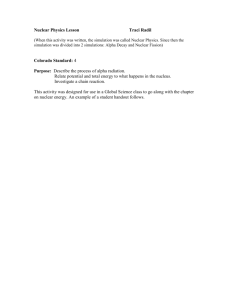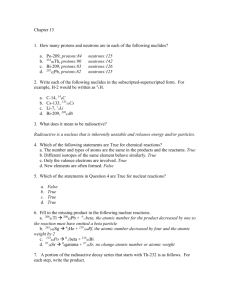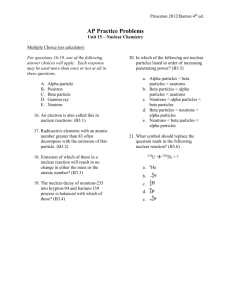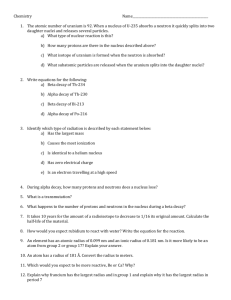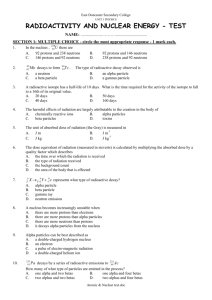Nuclear Chemistry
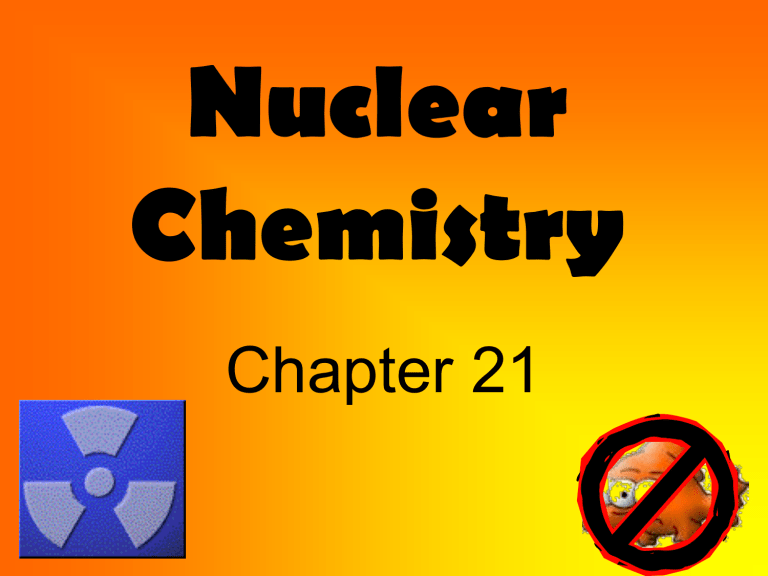
Nuclear
Chemistry
Chapter 21
Warm Up
• Astatine – 210 goes through alpha decay, beta decay and alpha decay in that order to become stable. Write the reactions that represent this process.
Goals for Nuclear Chem
1) 11. Nuclear processes are those in which an atomic nucleus changes, including radioactive decay of naturally occurring and human-made isotopes,nuclear fission, and nuclear fusion. As a basis for understanding this concept: a. Students know protons and neutrons in the nucleus are held together by nuclear forces that overcome the electromagnetic repulsion between the protons.
b. Students know the energy release per gram of material is much larger in nuclear fusion or fission reactions than in chemical reactions. The change in mass (calculated by E = mc 2 ) is small but significant in nuclear reactions.
c. Students know some naturally occurring isotopes of elements are radioactive, as are isotopes formed in nuclear reactions.
d. Students know the three most common forms of radioactive decay (alpha, beta, and gamma) and know how the nucleus changes in each type of decay.
e. Students know alpha, beta, and gamma radiation produce different amounts and kinds of damage in matter and have different penetrations.
Nuclear Chemistry
Nuclear Chemistry Deals with the study of the nucleus.
This deals with atoms protons, neutrons and their existence.
Types of Radiation
Alpha particles
Radiation
Beta particles Gamma particles
• Radiation occurs when a nucleus is unstable and must alter is components to obtain stability .
• When we are looking at any type of radiation or radioactive decay we must remember that matter is conserved !
Nuclear Stability
• Isotopes with low atomic numbers
– Stable ratio is 1 neutron to 1 proton
• Isotopes with high atomic numbers
– Stable ratio is 1.5 neutrons to 1 proton
• This creates the band of stability
• fig 28.6
Nuclear Stability
• Remember Nuclear
Forces.
• fig 28.6
• Protons have repulsive forces.
• Close distance between protons and neutrons keep the nucleus together.
Nuclear Stability and Decay
• Unstable isotopes will undergo decay to achieve a more stable ratio of neutrons to protons
• The type of decay depends on the ratio of neutrons to protons
– Too many neutrons. Turn neutrons to protons. (beta decay). Or the nucleus loses mass. (alpha decay)
– Too many protons, the atom captures electrons and turn protons to neutrons, this emits a positron
Alpha particles
• Helium nuclei
– Contains 2 protons and 2 neutrons
– Net charge of +2
– Has a mass of 4 amu
• High mass limits penetrability
– Looks like: 4
2
He or α
Alpha particles in a reaction
• Alpha radiation is emitted from U-238
238
92
U → 234
90
Th + 4
2
He
Is matter conserved?
Yes!
• Now you try!
• Alpha radiation is emitted from Rn-222
222
86
Rn → 218
84
Po+ 4
2
He
Is matter conserved?
Yes
Beta particles
• Fast moving electrons
• formed by the decomposition of a neutron in to a proton and the fast moving electron
• They have a negligible mass
– Consequently they are more penetrating than alpha particles
• They have a charge of -1
Beta particles in a reaction
• The general reaction
1
0 n → 1
1
H + 0
-1 e
• What does that mean?
• A neutron is converted into a proton
• So, the mass number remains the same but the atomic number increases by one
Beta particles in a reaction
• C-14 is a beta emitter, show the decay process
• 14
6
C → 14
7
N + 0
-1 e
• Is matter conserved?
• Yes!
• Now you try
• 40
19
K →
• 40
19
K → 40
20
Ca + 0
-1 e
Gamma Rays
• High energy electromagnetic radiation given off by a radioisotope
• Often emitted with alpha and beta particles
• Gamma rays have no mass and no charge, so they do not alter the atomic number or the mass number
• Gamma particles have the largest penetration ability
Gamma particles in a reaction
• 230
90
Th → 226
88
Ra + 4
2
He + γ
– When the alpha particle is released a huge amount of energy is also released (the gamma particle)!
• Is the following Alpha emission or beta emission?
• 234 Th - 0 B + 234 Pa
90 -1 91
• 238
92
U - 4
2
He + 234 Th
90
Radioactive
• All nuclei with atomic numbers greater than 83 are radioactive
• These nuclei have both too many neutrons and too many protons to be stable
– So most undergo decay
• Most emit alpha particles,
Transmutation
• The conversion of an atom of one element into an atom of another element
• This occurs in radioactive decay
• This can also occur when a high energy particle bombards the nucleus of an atom
Fission
• When some radioactive nuclei are bombarded with neutrons they undergo splitting of a nucleus into smaller fragments called fission
• Neutrons are released from fission reaction, creating a chain reaction
Nuclear Fission & Energy
• Nuclear fission can release an
amount of energy enormous
– Ex. 1kg of U-235 release the same amount of energy as 20,000 tons of dynamite
Energy is calculated by E=mc 2
E = Energy m = difference of mass c = speed of light
In fusion and fission a very small amount of mass of is converted to energy and visa versa.
How can we use fission energy?
• We need to control the energy released
– By releasing energy slower
• Neutron Moderation: slows the neutrons down
• Neutron Absorption: decrease neutrons that react
– By converting energy to heat
• Coolant removes heat from reactor core
• This creates a manageable amount of useable power
Nuclear Fusion
• Fusion occurs when nuclei combine to produce a nucleus of greater mass
• Usually release more energy than fission
• Only take place at temps greater than
40,000,000 ˚C
• Ex. 4 1
1
H + 2 0
-1 e → 4
2
He +
energy
Nuclear Fusion as an energy source
• JET (Joint European Torus) have achieved the
– Temperatures
– Densities
– Degrees of containment
Required to produce fusion power
Radiation in your life!
• Where do we use radiation?
– Energy Sources
– Disease Diagnosis
– Disease Treatment
– Biotech Tracers & Research
– Criminal Investigations
– Anthropological Dating
Radiation in your life!
• How do we measure your exposure level?
– Geiger counter
– Film badges


